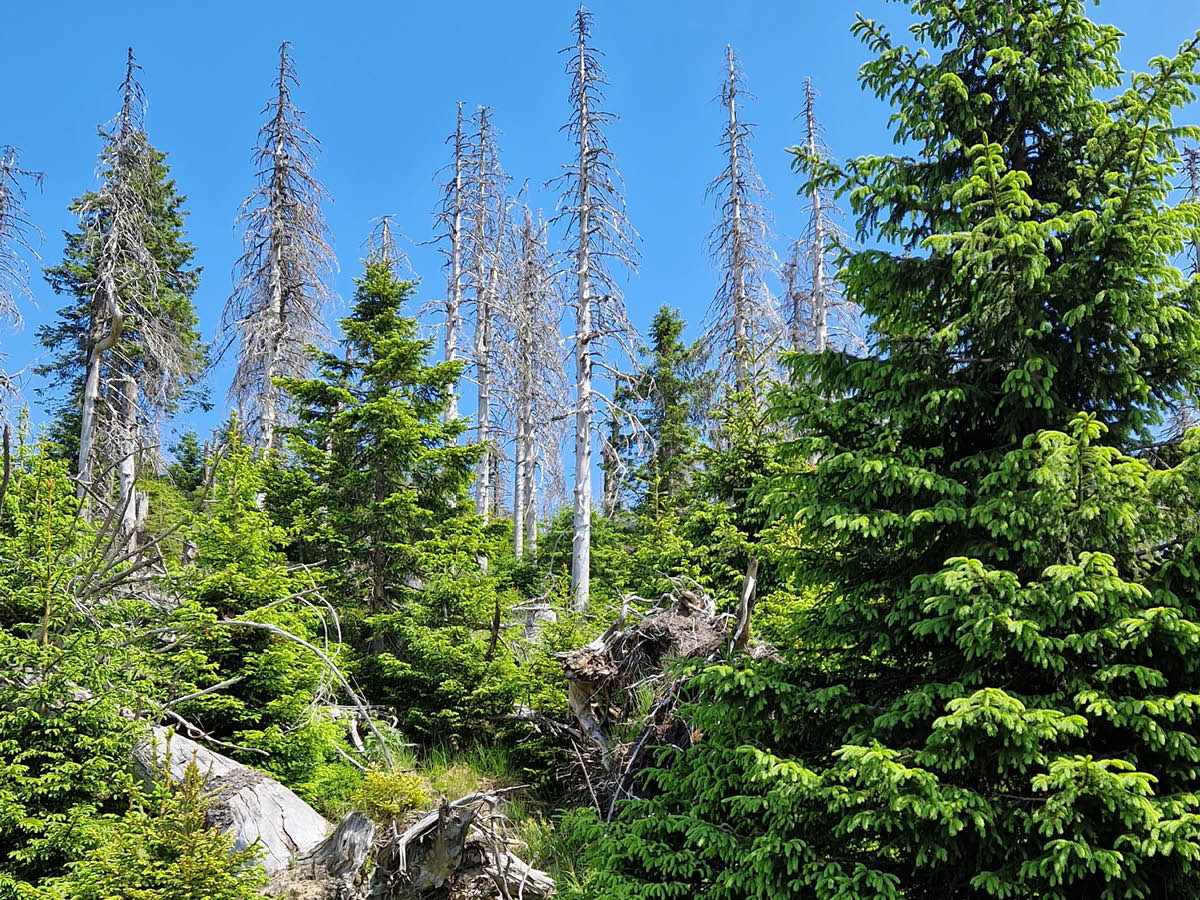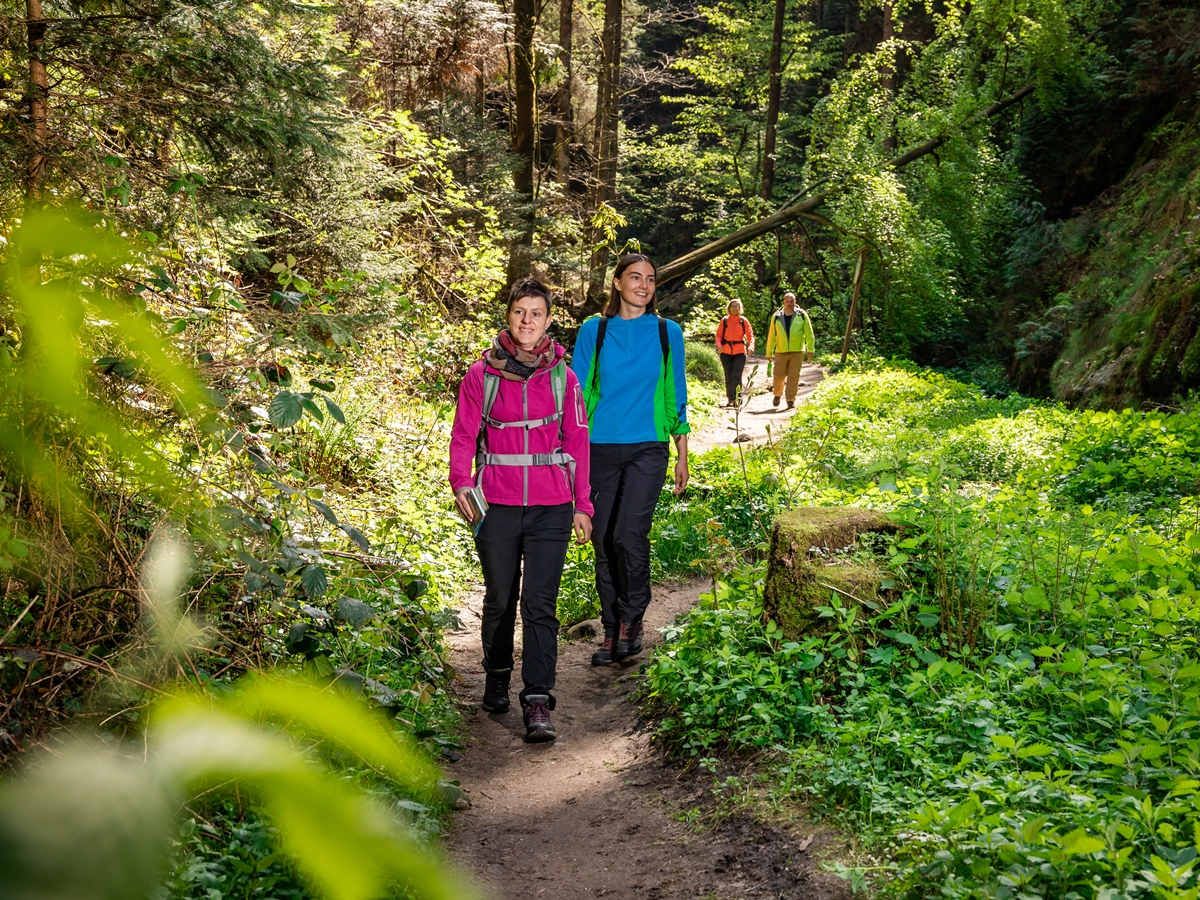The Changing Forest
Forests in transition to a new wilderness
In the Harz and Saxon Switzerland national park regions, the forest has changed considerably in recent years due to prolonged drought and subsequent bark beetle infestation. In keeping with the national park‘s motto “Let nature be nature”, nature is allowed to develop freely in large parts of the national park.
But this regeneration takes time. The sight of dead trees, which takes some getting used to for many visitors, is only a brief stopover on the way to the more species-rich forest of the future. Themed trails at various locations in the national parks illustrate this change with lots of background information.
Why are there so many dead trees?
In the Harz Mountains for example, large areas had to make way for mining and the forests were intensively utilised, especially in the post-war period. Reforestation was carried out in spruce monocultures. The Harz was actually a deciduous forest mountain range and spruce trees only grow there naturally from an altitude of over 700 metres. Similarly, there was a large proportion of monocultures in Saxon Switzerland.
Bark beetles have actually existed in these regions for around 5000 years. However, they were able to spread extremely quickly due to the low tree diversity. The trees are also particularly susceptible due to the storms, heatwaves and drought caused by climate change. The bark beetles can recognise weakened spruce trees by their smell and eat their way under the bark. In doing so, they cut the trees' supply lines, causing them to die.

The good news: The forest is alive!
At first glance, you may see many dead trees, but the forest is actually more alive than ever before! In fact, dead trees are habitats and ensure a greater diversity of species in the flora and fauna.
New young trees, including deciduous trees, grow, and herbs and grasses sprout, attracting new wildlife. Numerous forest species are dependent on dead wood: Fungi and microorganisms decompose the wood and form new nutrients for plants and insects, such as bees and beetles, find breeding grounds in it.
Insects provide an important food source for birds. Woodpeckers build their nesting cavities in the dead trees that are still standing, which are later used as roosts by dormice or owls. Bats also find roosts under the protruding bark and feed on the insects.
A new habitat is also being created for reptiles and amphibians, as well as mammals such as the wildcat and the lynx.
And it gets even better: carbon dioxide is stored in the rotting trunks and humus soils and new plants absorb and store the nutrients. This means that the emerging forest wilderness also has a protective function against climate change.
The importance of national parks
The fact that the forests are allowed to become wild again is primarily due to the conservation provided by the national parks. Their main task is to protect natural processes. Therefore, they intervene only in a few areas.
For example, dead trees along public transport routes and tourist destinations - including along the route of the Harz narrow-gauge railway - are pulled down or cut back. However, the natural cycle is interrupted as little as possible: the lying and bent trunks resemble the result of a storm.
In order to make the forests less susceptible to the rapid spread of bark beetles, deciduous trees are planted. Due to the spruce monocultures, there are too few deciduous trees for them to seed themselves. This is why, in the Harz Mountains, for example, 6.4 million deciduous trees were planted between 2008 and 2022.
The national parks do not consider bark beetles as a vermin, but as part of the natural ecosystem. However, to reduce the threat to commercial forests, 500 metre-wide safety strips have been established at the borders of the national park. Bark beetle trees are felled and removed there.
Experience the forest transformation in the Harz National Park
In the Harz Mountains - one of the largest national forest parks in Germany - you can experience the different stages of the changing forest.
Spruce monocultures, areas of dead wood and already naturalised forests: you will see a particularly varied picture along the road B4 between Bad Harzburg and Braunlage, around Torfhaus or on the ascent to Achtermannshöhe and the Brocken.
Depending on the altitude, you will also find wild beech, spruce and mixed forests on the mountain Quitschenberg, on the mountain Bruchberg, along the Clausthaler Flutgraben near Torfhaus, around the lake Oderteich or on the mountain Meineberg near the town Ilsenburg.
Further Tips
-
Discover the "primeval forest of tomorrow" on the WaldWandelWeg theme trail at the TorfHaus National Park Visitor Centre.
-
The numerous national park houses and visitor centres invite you to discover nature with interactive exhibitions and interesting information.
-
Go on a guided hike with the national park rangers and get first-hand information about the secrets of wildlife from the experts!
-
On a multi-day hiking tour through the Harz Mountains, you can explore the diversity of the national park region at your leisure. Hike on the Harz Witches Trail from Osterrose to Thale or from Wernigerode to Quedlinburg.




Experience the forest transformation in the Saxon Switzerland National Park
You can also observe the forest change in Saxon Switzerland. The national park offers all kinds of excursions and information programmes.
Our Tips
-
One themed trail that you should not miss is "The Nature trail on the bark beetle and forest reorganisation". Since 2007, a pure spruce forest has died there due to winter storm Kyrill and subsequently bark beetles. Experience how the forest has regenerated on its own in 15 years.
-
On the "Nature trail on forest development after the 2022 forest fire" you can compare photos of the forest situation before and immediately after the fire. The trail also provides information on measures to prevent future fires.
-
Visit the national parc centre in Bad Schandau: There is an exhibition covering the formation of the Elbe Sandstone Mountains up to today's relationship between people and nature. From 14 March 2024, there will be a temporary exhibition that presents the relationship between humans and nature in a more detailed way.
-
In Saxon Switzerland we would also recommend going on a guided hike with the national park rangers. You will discover the unique landscape and learn about its history, flaura and fauna and discuss current issues.
-
A multi-day hiking tour through Saxon Switzerland is a great way to discover the national park. You can choose between a circular tour covering the highlights of Saxon Switzerland, a 10-day tour along the Malerweg trail , an 8-day tour along the Malerweg trail or a short hiking trip along the Malerweg trail.
Credits: © AugustusTours; © Robert Michalk Photography; © Frank Exß Tourismusverband Sächsische Schweiz e.V.

















